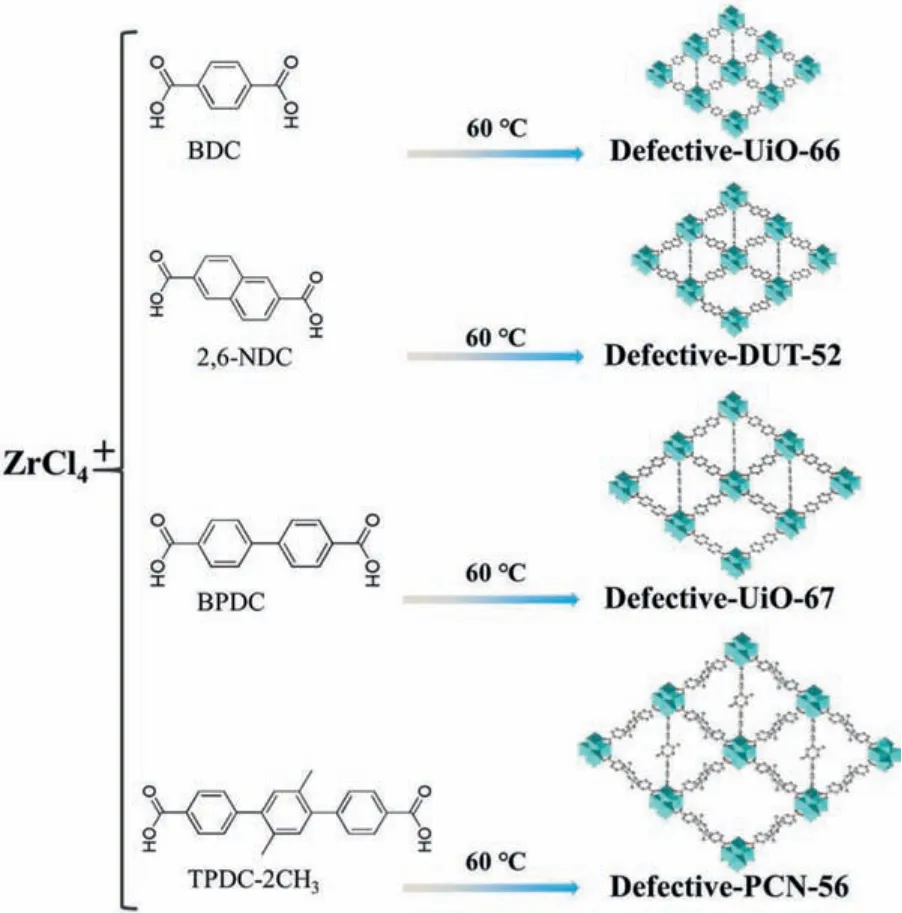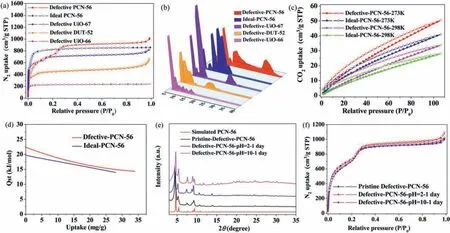A low-temperature synthesis-induced defect formation strategy for stable hierarchical porous metal-organic frameworks
Ge Huang,Yue Wang,Tianfu Liu
a Fujian Institute of Research on the Structure of Matter, State Key Laboratory of Structural Chemistry, Chinese Academy of Sciences, Fuzhou 350002, China
b College of Biological and Chemical Engineering, Chongqing University of Education, Chongqing 400067, China
Keywords:
Low-temperature induced
Defect formation strategy
Stable MOFs
Hierarchical porous MOFs
Lewis acid sites
ABSTRACT
A stable hierarchical porous metal-organic framework PCN-56 with abundant Lewis acid sites(denoted as Defective-PCN-56) was synthesized by the low-temperature synthesis-induced defect formation method.The existence of mesopore in structure was confirmed by N2 sorption isotherm and the successful encapsulation of large dye molecules.The Defective-PCN-56 has higher loading capacity toward anti-cancer drug Doxo compared with that of “nearly ideal-crystal” (denoted as Ideal-PCN-56)synthesized at high temperature, showing potential application as drug carrier.The low-temperature synthesis-induced defect formation strategy presented here provides a new and facile way to synthesize stable MOFs with the combination of intrinsic micropore and additional mesopore as well as abundant Lewis acid sites.
Metal-organic frameworks (MOFs) have attracted much attention due to their porosity,tailorability and diverse functionality[1-3].The pore size of MOFs, as a window for accepting guest molecules, plays an important role in realizing the functionalization of materials.Compared with the majority of ones so far are restricted to microporous regime in the field of MOFs,mesoporous MOFs have more advantages such as higher load on guest molecules, unrestricted diffusion of guest molecule, and better size-exclusion effect[4],which enable them to adsorb larger guest molecules [5]and enhance the interactions between the guest molecules and framework of MOFs [6].
In the past few years, some mesoporous MOFs have been reported [7-12].The classical synthesis methods can be summarized as follows:a)Increasing the length of ligands;b)Designing a reasonable ratio of metal to ligand;c)Ligand exchange;d)Adding soft-/hard-template; e) Adding a long-chain monocarboxylic acid as modulators to induce defects.However,these methods usually resort to tedious synthesis procedures and the obtained materials sometimes suffer from low structural stability, being difficult to apply in large-scale production.
As two contradictory attributes,the pore size enlargement and structural stability have been rarely achieved together.Jiang's group [9]used long-chain monocarboxylic acid as competitive reagent to create defects in MOFs, and successfully synthesized stable mesoporous materials.This study inspires us to ponder over the question that besides the induction of defects using competitive reagents for creating mesoporous structure, can the defects and mesopore be realized by simply controlling the synthesis condition?If it is possible,the synthesis expense including the raw material and time, would be greatly reduced, and the large-scale production could achieve.Therefore, we attempted to synthesize stable mesoporous MOFs by control of the synthesis condition without any modulator [13,14].
Zirconium-based MOFs attract our interest due to their excellent thermal and chemical stability.In the actual synthesized MOF materials, the structures always contain a considerable density of defects [ 15-22].The existence of defects provides not only exposed metal sites (Lewis acid sites), but also can free up a larger pore space to generate hierarchical pore structure.
In this work,we choose 12-linked Zr-MOF with fcu topology as a prototype to create hierarchical micro-mesoporous materials with existence of abundant Lewis acid sites (Fig.1).A series of isostructural Zr-MOF including UiO-66 [23], DUT-52 [24], UiO-67[23]and PCN-56[25],with the linkers elongating from BDC to 2,6-NDC,BPDC and TPDC-2CH3,were synthesized.It is found that defects can been induced in all those four structures at the low synthesis temperature 60°C.However, only the organic linker longer than BPDC can generate significant amount of mesopore in structure, which was confirmed by N2sorption isotherm and the successful encapsulation of large dye molecules.The Defective-PCN-56 has higher loading capacity toward anti-cancer drug Doxo compared with that of “nearly ideal-crystal” (denoted as Ideal-PCN-56) synthesized at high temperature, showing potential application as drug carrier.

Fig.1.The synthetic route for Defective-UiO-66, DUT-52, UiO-67, and PCN-56.
The four compounds were synthesized by a reaction using the same metal-ligand molar ratio (2:1) in DMF at 60°C.As mentioned in Fig.S1 (Supporting information), the experimental powder X-ray powder diffractor(PXRD)patterns match very well with the simulated ones, which means the pure phases of these four materials have been obtained.As shown in Fig.2a, the N2sorption isotherms of UiO-66 and DUT-52 display much lower uptake (173 cm3/g and 326 cm3/g,respectively) than those of the materials synthesized at higher temperature in previous report, indicating the existence of higher density of defect in structures [23,24].However, pore size distributions show that the defect only causes very small amount of mesopore in structures (Table S1 in Supporting information).Elongation of ligands to BPDC, the N2sorption isotherm of obtained UiO-67 starts to show slight stepwise behaviors, and larger amount of mesopore was observed(uptake: 574 cm3/g, BET: 2501 m2/g, pore width: 0.6~2.5 nm)[23].Further elongation of ligand to TPDC-2CH3, the N2sorption isotherm of Detective-PCN-56 exhibits an obvious stepwise adsorption, which belongs to the type VI adsorption(adsorption capacity: 960.9 mmol/g; Langmuir surface area:4182 m2/g).This is a characteristic feature of hierarchical porosity in MOFs materials.The pore size distribution indicates that a large proportion of pore in PCN-56 distributed in the mesoporous region from 2.0 nm to 3.9 nm under low-temperature synthetic conditions (Fig.2b).Interestingly, increasing synthesis temperature to 90°C results in the disappearance of stepwise adsorption behaviors.The adsorption capacity is 858.2 cm3/g (Langmuir surface area 3735 m2/g) and pore size distribution is around 0.63~1.85 nm, approaching the value reported before [26].Therefore, the higher synthesis temperature can result in less defects in the obtained structure, while the lower synthesis temperature induced the missing of linker and generation of mesopore in structure.Accompanying with the existence of mesopore, structural defect causes abundant Lewis acid sites in material.Lewis acid sites can strongly polarize gas adsorbents, and thus are favorable to CO2uptakes as well as adsorption enthalpy(Qst)[27].From Figs.2c and d,we can see that the Qstfor Defective-PCN-56 is 22.41 kJ/mol,which is larger than that of the Ideal-PCN-56 (Qst=19.69 kJ/mol).Furthermore, the thermogravimetric analyses (Fig.S2 in Supporting information)show that the defective-PCN-56 synthesized at 60°C has lower weight loss than the Ideal-PCN-56[13],indicating fewer organic components in Defective-PCN-56.Additional evidence came from FT-Infrared spectra(Fig.S3 in Supporting information)where there are more characteristic peaks(~2930 cm-1) from methyl group on ligand for Ideal-PCN-56,and more characteristic peaks(~3413 cm-1) from associated hydroxy group on metal nodes for Defective-PCN-56 [28].

Fig.2.(a)The N2 sorption isotherms of Detective-UiO-66,DUT-52,UiO-67,and PCN-56 at 77 K;(b)The pore widths of Detective-UiO-66,DUT-52,UiO-67,PCN-56 and Ideal-PCN-56;(c)The CO2 sorption isotherms of Detective-/Ideal-PCN-56 at 273 K and 298 K;(d)The CO2 adsorption enthalpy of Detective-/Ideal-PCN-56;(e)The PXRD patterns of Defective-PCN-56 treated with pH 2 and pH 10 aqueous solution for 1 day;(f)The N2 sorption isotherms at 77 K of Defective-PCN-56 after being treated with pH 2 and pH 10 aqueous solution for 1 day.

Fig.3.(a)UV-vis spectra changes of Indigo Carmine(Insert:the photographs of IC solution before and after it was adsorbed by Defective-PCN-56);(b)UV-vis spectra changes of Alizarin Red S(Insert:the photographs of ACS solution before and after it was adsorbed by Defective-PCN-56);(c)The SEM image of as-prepared Defective-PCN-56;(d)The loading capacities of Defective-PCN-56 (red) and Ideal-PCN-56 (blue) in different concentration of Doxo aqueous solutions.
According to Hard and Soft Acids and Bases (HSAB) principle[29,30],the MOFs formed by the combination of the hard acid such as Zr4+and the hard base such as carboxylic acid usually exhibits excellent structural stability.In PCN-56, the hydrophobic methyl groups on linker can further enhance the water stability of material[31].Figs.2e and f show that both the PXRD patterns and N2sorption isotherms at 77 K have not changed after Defective-PCN-56 being immersed into pH 2 or pH 10 aqueous solution for 1 day,indicating the excellent stability of the obtained hierarchical porous materials [32].Therefore, based on this strategy, we provide a simple new way for preparation of stable materials with high stability,hierarchical porosity,and abundant Lewis acid sites.
Generally,hierarchical meso-microporous materials have greater adsorption capacity than microporous materials.Therefore,Defective-PCN-56 can be used to adsorb large organic dyes[33].Herein,Indigo Carmine(IC)and Alizarin Red S(ARS),two anionic dyes with sulfonate groups,were selected to demonstrate that their capability for dye adsorption.Figs.3a and b show that these dyes(0.0044 mmol ARSin5 mL water solution or0.0037 mmolICin5 mL water solution)can be completely absorbed by 5 mg Defective-PCN-56 within 24 h(Figs.S4-S7 in Supporting information).From the PXRD pattern of Defective-PCN-56 after dye adsorption (Fig.S8 in Supporting information), it can be seen that the crystal morphology of the material retains intact, indicating the integrity of crystalline structure.Fig.3c shows that the size of as-prepared Detective-PCN-56 is about 100 nm, and they disperse very well without any agglomeration.Furthermore, the loading capacity for the macromolecular anti-cancer drug doxorubicin(Doxo)were investigated [34].Both the larger specific surface area and hierarchical pores endow the material high Doxo uptake of 34.4 wt%, which is significantly higher than 7.7 wt%for Ideal-PCN-56(Fig.3d).Therefore, Defective-PCN-56, with high stability and loading amount,exhibits potential application for drug delivery.
In conclusion, a stable hierarchical porous metal-organic framework PCN-56 with abundant Lewis acid sites has been synthesized by a low-temperature synthesis-induced defect formation method.It can retain crystalintact under the condition of pH2or pH10,and has higher loading amount for macromolecular drug Doxo compared with the I deal-PCN-56synthesized at higher temperature.The strategy presented here provides a facile way to synthesizes table MOFs with the combination of intrinsic micropore, additional mesopore and abundant Lewis acid sites which are highly desirable for various applications.
Acknowledgments
This work was financially supported by National Natural Science Foundation of China (NSFC, No.21871267), the Science and Technology Research Program of Chongqing Municipal Education Commission (No.KJQN201801602), the Key Laboratory for Green Chemical Technology of Chongqing University of Education(No.2016xjpt08),and the Young Teachers'Growth Plan of Chongqing University of Education (No.YX-2019-01).
Appendix A.Supplementary data
Supplementary material related to this article can be found,in the online version,at doi:https://doi.org/10.1016/j.cclet.2019.04.030.
 Chinese Chemical Letters2019年12期
Chinese Chemical Letters2019年12期
- Chinese Chemical Letters的其它文章
- A roadway of exploring polymer science, a lifetime of nurturing polymer scientists
- A personal journey on using polymerization in aqueous dispersed media to synthesize polymers with branched structures
- Amphiphilic block copolymers directed synthesis of mesoporous nickel-based oxides with bimodal mesopores and nanocrystal-assembled walls
- Synthesis of magnetic polyphosphazene-Ag composite particles as surface enhanced Raman spectroscopy substrates for the detection of melamine
- Photothermal performance of MFe2O4 nanoparticles
- Enhanced electrochemical performance and mechanism study of AgLi1/3Sn2/3O2 for lithium storage
